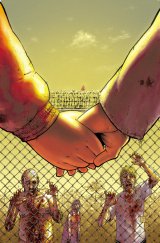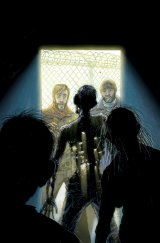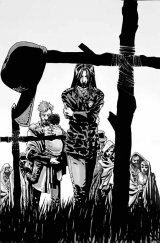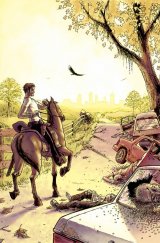

Home  Comics
Comics  AIIEEEE! The Dead Walk!
AIIEEEE! The Dead Walk!
   |
    |
Writer: Robert Kirkman.
Artists: Charlie Adlard, Cliff Rathburn, Tony Moore. Issue number: 1, 2, 3, 4. Publisher: Image. Format: trade paperback. Weíve all dreamt of a zombie apocalypse, right? The dead rising and infecting others, until the globe is swamped under a horde of walking corpses, hunting down the living with an otherworldly determination, stinking of rotten flesh, corralling the last few survivors into small pockets of resistance, forcing them into a battle of attrition which can have only one conclusion. Who hasnít wanted to stand atop the walls, gun in hand, to meet those dead bastards and teach them how to attack your bullets with their heads, as wave after wave of them surge forth, overwhelming the defences and forcing you to drop back, prepare for the last stand and then perform an unlikely escape with only the best of your friends? Which is about where most zombie stories end. Few deal with living in an undead world, surviving when you are no longer top of the food chain, the actual day-to-day problems, the emotional and mental difficulties that go with being surrounded by constant death. The Walking Dead is a whole different story. Kirkman kicks off the story and the first volume with the protagonist, Officer Rick Grimes, getting into a gunfight and getting shot, ending up in a coma, only waking after society has crumbled. Iíll admit itís a little too neat, but I didnít balk at it in Ď28 Days Laterí so I wonít here. Itís also a good way to get the readers to empathise with the main character, as everything is as new to us as it is to him. We get to see the ruins of civilisation alongside Rick and share his initial confusion at the presence of the undead, all terminally determined to introduce him to Bite Club. The zombies are the traditional type, slow and mindless (metaphorically, anyway, some of the head injuries show they do indeed have minds and it squirts out of their ears when hit hard enough), with an insatiable hunger for human flesh. They are my favourite monster, because they may also represent many other things, not just animate cannibalistic corpses. They are the mindless crowd or our own death personified or just rotting fleshy automatons, bereft of heart and soul. They cannot be reasoned with, or bargained with, or appealed to. They are simple, uncomplicated and implacable, but they are not unstoppable. Anyone can, and in TWD does, fight the horde of smelly rotting ex-people. You donít have to be a hero, super or otherwise. Mechanic, shop assistant, delivery boy, mother, old fart, whatever your role in society was, itís now changed to kicking zombie arse on a more or less permanent basis. Itís not all just headshotty goodness, either. The story is fairly character-driven, and the characters are not stupid. They know thereís a limited supply of bullets, so weíre treated to a lot of skull chopping and head smashing, as various implements are wielded with deadly intent and little finesse. I think Charlie ĎFucking Tracerí Adlard and Tony ĎCover Boyí Moore do a damn good head wound, whatever else their artistic faults are. The actual means of survival are touched on constantly throughout the story, not just the killing of zombies (surprisingly difficult when you donít have a shopping centre to hide in) but also finding food and shelter in a world gone undead. The constant hunt not just for sustenance, but for things more difficult to qualify such as peace and safety, is a constant, and probably the most important, theme in the comic. Kirkman, unlike a lot of other writers, isnít scared to kill off characters, and sometimes the fatalities come at a bewildering rate, and not all of them stem from zombies, either. He breaks up families and marriages seemingly at random, bringing lives to hasty unpleasant conclusions, which is fairly realistic. They are solid, well-rounded characters in the main, and though he sometimes scrapes gracelessly up against stereotypes (token black man, check), Kirkman often dodges the Bullet of Shitness. He gives them an extra dimension or two, some little facet of character or quirk of dialogue that frees them from Cardboard Cut-out Hell. Thatís not to say youíll like them, good God, no. Many people confuse empathy with sympathy, thinking characters have to be likeable in order for the audience to care about them. This is bullshit of the smelliest odour. Characters can be complete and utter bastards, but an audience can still empathise with them, if they are given some depth to immerse themselves in, some skilful characterisation to make them think (fuck, imagine that, an audience thinking! God forbid, eh?). There will be some characters you like, and some you donít. Just like real people, unless youíre bitter as I am and automatically hate everyone on sight. Admittedly, there are cliched moments, but these are far outweighed by the unexpected but bizarrely logical happenings. One annoyance is Kirkman bolding every other word like this in the dialogue for emphasis, but he quickly outgrows that habit and itís understandable under the circumstances anyway. Dialogue, character and story all take some unusual turns, but itís for the better and everything falls within real human reactions to extreme situations, however weird they seem. People complain and whine, they react badly to death, grief and stress, and itís nice to see the whole process in itís ugly, unpleasant totality for once, rather than the usual ďDied, so sad, life goes on.Ē trivialisation. The art, as always, is a big part of any comic. This comic is black, white and grey only, no flashy colour here, thank you. Itís monochrome, baby, and thatís the way we like it. This emphasises the bleakness of the story and the environment as a whole, as well as being cheap as chips. I reckon Image think theyíre putting out a full colour comic but the staff spunk it all on cocaine and prostitutes every Friday night. More power to them I say. Anyway. Moore does some cracking covers, and does all the art for the first volume. I find his style to be a little too cartoonish to suit the story, and heís no great shakes when it comes to facial expressions either, lacking subtlety. He does a fucking great zombie, though, and his environments are really good too. Some of his full-page stuff is the dogís bollocks, I think his quality improves in proportion to the space he has to work with. Adlard takes up the torch from the second volume on, and although heís sometimes a little too vague and doesnít do enough detail (big mistake, as detail really stands out with the black, white and grey artwork), heís an overall improvement. He does a good zombie, his characters have a wide range of facial expressions with some nice varying touches (ďGive me confused with a hint of lemon!Ē) and thereís some good dramatic use of shadow. Overall, although the story itself sometimes progresses quickly, the art has quite a static feel to it. For once, this is no bad thing, giving an evenly paced progression no matter what is actually going on. Some individual panels have a marvellous sense of energy, but itís not carried on throughout the page. Thereís plenty happening, on many levels. Thereís the obvious, group interactions, shootings, conversations and so forth, the day-to-day workings of a group of people in constant danger. Then thereís the not so obvious, the changing (or re-emergence) of certain social mores, how attitudes adjust (or donít), how the fabric of a society might change under strain, basically, as well as the zombies and what they represent. Ultimately, this is not a zombie comic. Itís not really about the zombies. Like all the best stories, itís about the characters, the people in the story, what they go through and how they act and react. Itís about the journey, not the destination. This might be pretty unconventional these days, when storytelling in most media is stiffer than a splinted penis on Viagra, but I see no reason to let folk who think rigidly structured stories are best rule the earth. You can pick up all four volumes for less than £10 each if you put in a bit of effort, and they are well worth it. Each volume collects six issues of the ongoing series, basically a chapter of the story, and the only problem I have with them is that they are just not long enough. Kirkman should know that his story is strong enough not to have to rely on cliff-hanger endings (take note, all you fucking hacks out there). Once in a while is okay, but the lure of good story and character development is much more attractive than what-will-happen-next-kids bullshit immediacy. Itís got zombies in it, for fuckís sake. What more do you want?    Home |
|





